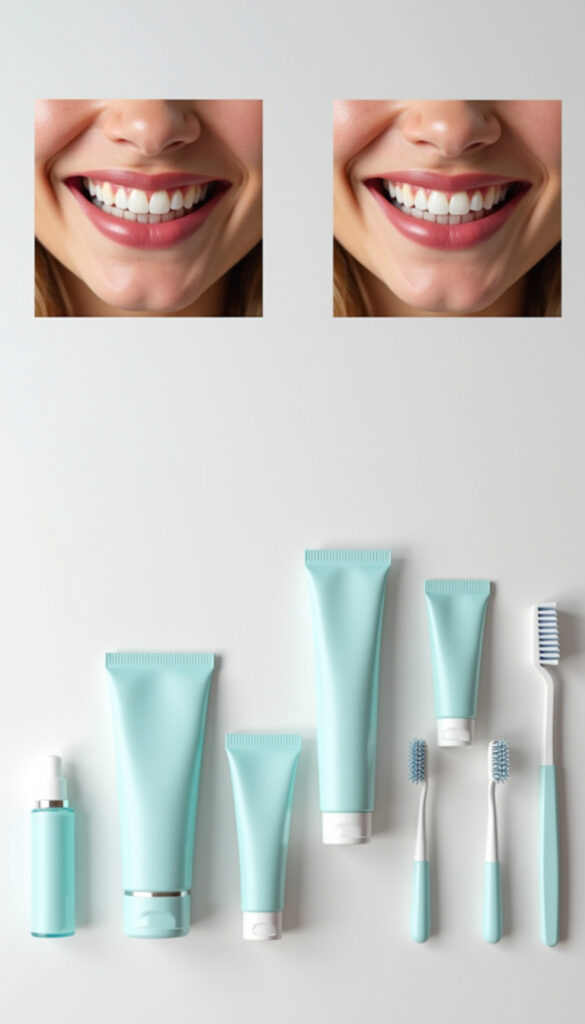Learning how to whiten teeth safely can transform your smile and boost your confidence. Many people struggle with yellow or stained teeth from daily habits like drinking coffee or aging.

Why Your Teeth Get Stained
Your teeth can lose their bright white color for many reasons. The outer layer of your teeth, called enamel, can pick up stains over time. Here are the main causes:
Food and Drinks:
- Coffee and tea
- Red wine
- Dark sodas
- Berries and tomato sauce
- Soy sauce
Lifestyle Habits:
- Smoking cigarettes
- Chewing tobacco
- Poor brushing habits
Natural Causes:
- Getting older
- Genetics
- Some medications
- Tooth injuries
Understanding why teeth get stained helps you choose the best whitening method for your needs.
Professional Teeth Whitening Options
Professional whitening gives you the fastest and strongest results. Dentists use special tools and stronger whitening products than you can buy at stores.
In-Office Whitening Treatments
When you visit a dentist for whitening, they use powerful bleaching gels. The process usually takes one to two hours. Here’s what happens: 1. Your dentist protects your gums with a special barrier 2. They apply a strong whitening gel to your teeth 3. Sometimes they use a special light to speed up the process 4. You can see results right away This method costs more money, but it works very well. Most people see their teeth get three to eight shades whiter in just one visit.
Custom Whitening Trays from Your Dentist
Your dentist can make special trays that fit your teeth perfectly. You take these home and use them with professional whitening gel. This method takes longer but costs less than in-office treatment. The trays fit better than store-bought ones, so the whitening gel works more evenly. You wear them for a few hours each day or overnight for one to two weeks.
At-Home Whitening Methods
You have many choices for whitening your teeth at home. These methods cost less than professional treatment but take more time to work.
Whitening Toothpaste
Whitening toothpaste contains mild scrubbing particles and gentle chemicals. These help remove surface stains when you brush regularly. Look for toothpaste with the American Dental Association (ADA) seal. This means it’s safe and works as promised. Use whitening toothpaste twice daily for best results. Keep in mind that whitening toothpaste only removes surface stains. It won’t change the natural color of your teeth like stronger whitening methods can.
Whitening Strips
Over-the-counter whitening strips are thin pieces of plastic coated with whitening gel. You stick them on your teeth and leave them for 30 minutes to an hour.
How to Use Whitening Strips:
1. Brush your teeth before applying
2. Remove the strips from the package
3. Place them carefully on your teeth
4. Leave them on for the time shown on the box
5. Remove and throw away the strips
6. Rinse your mouth with water
Most strip treatments last two weeks. You should see results after a few days of use.
Whitening Gels and Pens
Whitening gels come in small tubes or pen-like containers. You brush the gel directly onto your teeth. The gel is clear and dries quickly. This method lets you target specific teeth that need more whitening. It’s also easy to use when you’re busy or traveling.
Whitening Mouthwash
Whitening mouthwash works like regular mouthwash but contains mild whitening ingredients. You swish it in your mouth for 60 seconds before spitting it out. This is the gentlest whitening method, but it also gives the smallest results. It works best when combined with other whitening methods.
Natural Whitening Remedies
Some people prefer natural methods to whiten their teeth. While these are gentler, they don’t work as well as products made for whitening.
Baking Soda
Baking soda has mild scrubbing properties that can remove surface stains. You can brush with a paste made from baking soda and water once or twice a week. Don’t use baking soda too often because it can wear down your tooth enamel over time.
Oil Pulling
Oil pulling means swishing coconut oil or sesame oil in your mouth for 10 to 20 minutes. Some people believe this removes stains and improves oral health. While oil pulling is safe, there’s not much scientific proof that it whitens teeth. It may help remove bacteria that cause stains.
Hydrogen Peroxide Rinse
You can make a mouth rinse with equal parts water and hydrogen peroxide. Swish this mixture for 30 seconds, then spit it out and rinse with plain water. Use only 3% hydrogen peroxide from the drugstore. Stronger types can hurt your mouth and teeth.
Important Safety Tips
Whitening your teeth safely means following directions and watching for problems. Here are key safety rules to follow:
Read All Instructions Carefully
Every whitening product has specific directions. Follow them exactly to avoid problems. Don’t use products longer or more often than recommended.
Start Slowly
If you’ve never used whitening products before, start with the gentlest method. This helps you see how your teeth react.
Watch for Tooth Sensitivity
Many people get sensitive teeth when whitening. If your teeth hurt when eating hot or cold foods, take a break from whitening. You can use toothpaste made for sensitive teeth to help with discomfort. Wait until the sensitivity goes away before continuing treatment.
Don’t Overdo It
Using too much whitening product or using it too often can damage your teeth. Stick to the schedule on the product package.
Protect Your Gums
Keep whitening products away from your gums when possible. If gel gets on your gums, wipe it off right away to prevent irritation.
What to Expect from Whitening
Different whitening methods give different results. Here’s what you can realistically expect:
Professional In-Office Treatment:
- Results appear immediately
- Teeth can get 3-8 shades whiter
- Effects last 1-3 years with good care
At-Home Professional Trays:
- Results appear after 1-2 weeks
- Teeth get 2-6 shades whiter
- Effects last 1-2 years
Over-the-Counter Products:
- Results appear after several days to weeks
- Teeth get 1-3 shades whiter
- Effects last 6 months to 1 year
Natural Methods:
- Results appear after weeks or months
- Teeth get slightly whiter
- Effects vary widely
Keeping Your Teeth White
Once you whiten your teeth, you want to keep them looking great. Here are the best ways to maintain your white smile:
Good Daily Habits
Brush your teeth twice daily with fluoride toothpaste. Floss every day to remove plaque between teeth. Use mouthwash to kill bacteria that can cause stains.
Limit Staining Foods and Drinks
You don’t have to give up coffee or wine completely, but try to limit them. When you do have staining drinks, use a straw to keep them away from your teeth. Rinse your mouth with water after eating or drinking things that can stain your teeth.
Don’t Smoke
Smoking is one of the worst things for white teeth. The tar and nicotine in cigarettes cause deep, hard-to-remove stains.
Regular Dental Cleanings
Visit your dentist every six months for professional cleanings. This removes plaque and surface stains that regular brushing can’t get.
When to See a Dentist
Sometimes you need professional help with teeth whitening. See your dentist if:
- Your teeth don’t respond to over-the-counter products
- You have severe tooth sensitivity
- Your gums become very irritated
- You have crowns or fillings that don’t match your whitened teeth
- You want the fastest possible results
Your dentist can also tell you if whitening is right for you. Some people have tooth problems that make whitening unsafe.
Common Whitening Mistakes to Avoid
Don’t make these common errors when whitening your teeth:
- Using Products Too Often: Following the package directions exactly prevents damage to your teeth and gums.
- Expecting Instant Results: Most at-home products take time to work. Be patient and consistent for best results.
- Ignoring Tooth Pain: Stop using whitening products if your teeth become very sensitive or painful.
- Whitening Damaged Teeth: Fix cavities and other dental problems before starting any whitening treatment.
- Mixing Different Products: Don’t use multiple whitening products at the same time unless your dentist says it’s okay.
As teeth whitening technology continues to improve, you’ll have even more safe and effective options for achieving your brightest smile in the coming years.

Lifebing is driven by an unrelenting passion for promoting health and well-being, our team is wholly committed to curating exceptional content and immersive experiences.
